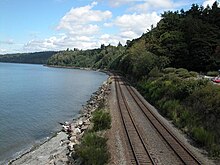Burlington Northern Railroad
| File:Burlington Northern Herald.png | |
 The Burlington Northern system (shown in green) at the time of the BNSF merger. | |
| Overview | |
|---|---|
| Headquarters | St. Paul, Minnesota |
| Reporting mark | BN, BNFE, BNFT |
| Locale | Alabama, Arkansas, California, Colorado, Florida, Idaho, Illinois, Iowa, Kansas, Kentucky, Minnesota, Mississippi, Missouri, Montana, Nebraska, North Dakota, Oklahoma, Oregon, South Dakota, Tennessee, Texas, Washington, Wisconsin, and Wyoming |
| Dates of operation | 1970–1995 |
| Successor | BNSF |
The Burlington Northern Railroad (reporting mark BN) was a United States-based railroad company operating between 1970 and 1995.
History
The Burlington Northern was the product of a March 2, 1970 merger comprising the Great Northern Railway, the Northern Pacific Railway, the Chicago, Burlington and Quincy Railroad, and the Spokane, Portland and Seattle Railway. Consent for this merger came only on the fourth attempt dating back to the days of James J. Hill, but for many years they shared a headquarters building in Saint Paul, Minnesota until the merger was finally approved. On November 21, 1980, the former St. Louis - San Francisco Railway was acquired. In 1981 corporate headquarters of parent Burlington Northern Inc. were moved to Seattle, Washington, and in 1988, after its non-rail operations were spun off as Burlington Resources, to Fort Worth, Texas.
On December 31, 1996, the Burlington Northern merged with the Atchison, Topeka and Santa Fe Railway to form the Burlington Northern and Santa Fe Railway.
Route

The Burlington Northern traversed the most northerly route of any railroad in the western United States. This route started at Chicago, Illinois and ran west-northwest to La Crosse, Wisconsin. From here the route continued northwest through Minneapolis and St. Paul, Minnesota to Grand Forks, North Dakota. From Grand Forks the route ran west through North Dakota, Montana, and Idaho to Spokane, Washington. At Spokane the route split into three routes. The former Great Northern route proceeded west to Wenatchee, Washington, crossed under the Cascade Range at New Cascade Tunnel, and descended into the Puget Sound region through Everett, Washington. The former Northern Pacific proceeded southwest towards the Tri-Cities, turned northwesterly to Yakima, Washington, and crossed under the Cascade Range at Stampede Tunnel, descending into the Green River Valley at Auburn, Washington, where it connected with existing NP lines running from British Columbia to Portland, Oregon. The Spokane, Portland and Seattle also proceeded southwest to the Tri-Cities, then followed the north bank of the Columbia River to Vancouver, Washington.
With the acquisition of the St. Louis - San Francisco Railway, the route was extended into the South Central and Southeastern United States.
Rolling stock notes

The Burlington Northern's locomotive livery painted the top quarter or so of the locomotive black and the rest in the corporation's official "cascade" green, with a white BN logo. Often, the front of the locomotive was striped with white and green for visibility. In 1985, several locomotives test ran a paint alteration of orange and black stripes on the cab face and nose to raise visibility at grade crossings. At the same time, the logo and road number switched locations on the body. The BN logo moved to the long hood along with the words "Burlington Northern" painted in white alongside the herald on the hood of the unit. The road number moved to the panel under the side cab window where the BN logo normally resides.
See also
References
- Handbook of Texas Online. "BURLINGTON SYSTEM". Retrieved 26 May 2005.
